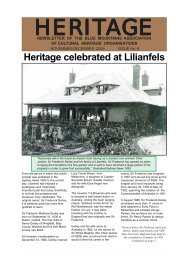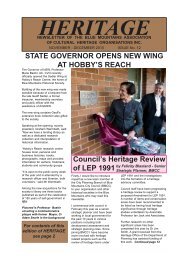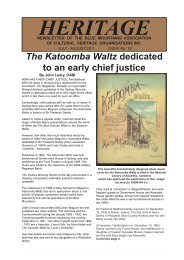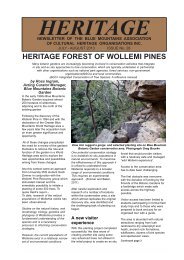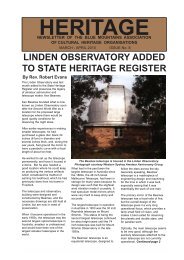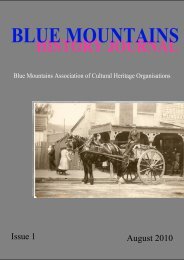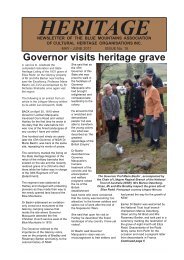Blue Mountains History Journal Issue 3
Blue Mountains History Journal Issue 3
Blue Mountains History Journal Issue 3
You also want an ePaper? Increase the reach of your titles
YUMPU automatically turns print PDFs into web optimized ePapers that Google loves.
<strong>Blue</strong> <strong>Mountains</strong> <strong>History</strong> <strong>Journal</strong> 3: 2012<br />
Figure 5 provides an example of<br />
a map depicting a <strong>Blue</strong><br />
<strong>Mountains</strong> roughly from Taralga<br />
to the Hunter Range (Hughes<br />
1870).<br />
Figure 5. Portion of William Hughes’ 1870 map of NSW (Hughes 1870).<br />
While this analysis was not<br />
rigorous, it can be seen that<br />
nineteenth century cartographers<br />
overwhelmingly considered the<br />
<strong>Mountains</strong> to extend at least as<br />
far as Mounts Werong and<br />
Colong in the south. To the<br />
north, nearly all cartographers<br />
considered the <strong>Mountains</strong> to<br />
extend at least as far as the<br />
Capertee and Colo Rivers. As to<br />
the eastern and western extent, in<br />
most cases the intent is obscure.<br />
An 1882 Bartholomew map of<br />
Australia depicts the <strong>Blue</strong><br />
<strong>Mountains</strong> following the Great<br />
Dividing Range from west of<br />
Goulburn to around Capertee, as<br />
opposed to the more<br />
‘mountainous’ terrain to the east<br />
of the divide which appears to be<br />
the target of most maps<br />
(Bartholomew 1882).<br />
No temporal trend could be found in the extent of the <strong>Blue</strong> <strong>Mountains</strong> as indicated by the 41 maps.<br />
Fourteen of them were by John Bartholomew or his son John George Bartholomew, in the period 1850 to<br />
1903, and there is no consistency or trend even within those.<br />
The prevailing cartographic notion of an extensive <strong>Blue</strong> <strong>Mountains</strong> did not suddenly die out in 1903. For<br />
instance, maps in a 1920 atlas variously showed that the <strong>Blue</strong> <strong>Mountains</strong> extended from Crookwell to<br />
Rylstone, Tuglow to Newnes; and Tuena (northwest of Crookwell) to Mudgee (Philip 1920).<br />
Nineteenth century textual references<br />
There are countless textual references to crossing the <strong>Blue</strong> <strong>Mountains</strong>, or places and events in the <strong>Blue</strong><br />
<strong>Mountains</strong>, but very few provide a meaningful interpretation of the extent of the <strong>Mountains</strong>.<br />
Some writers equated the <strong>Blue</strong> <strong>Mountains</strong> to the entire Great Dividing Range. An official party exploring<br />
the Brisbane River in 1825 reported<br />
“... ; the <strong>Blue</strong> <strong>Mountains</strong> apparently distant about ten leagues.” (Gray 1825)<br />
and an 1851 article first published in The Times about the gold discoveries in Australia mentioned that the<br />
<strong>Blue</strong> <strong>Mountains</strong> extended from<br />
“... the 38th degree of south latitude to the Tropic of Capricorn, ...” (Anonymous 1851, col.1).<br />
9




